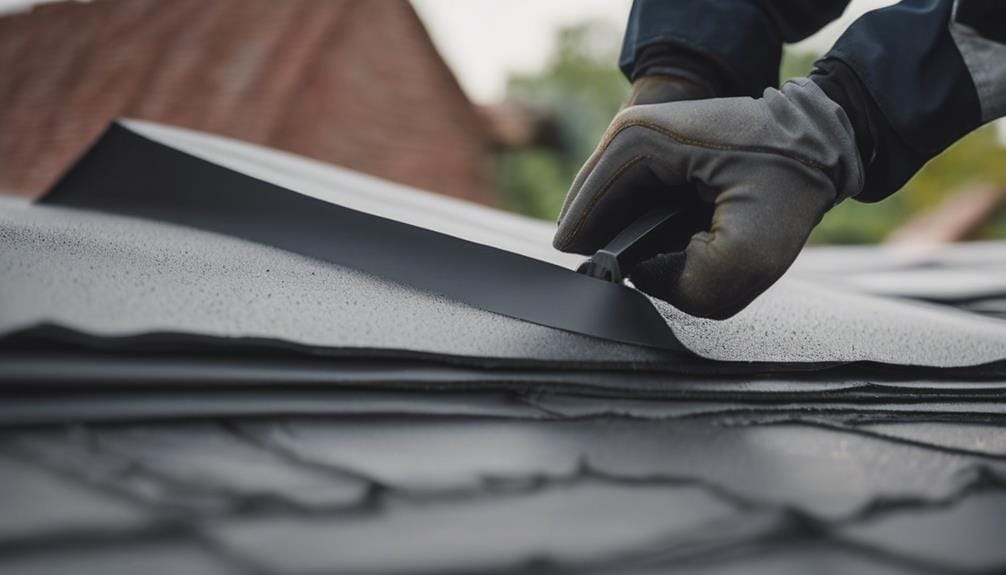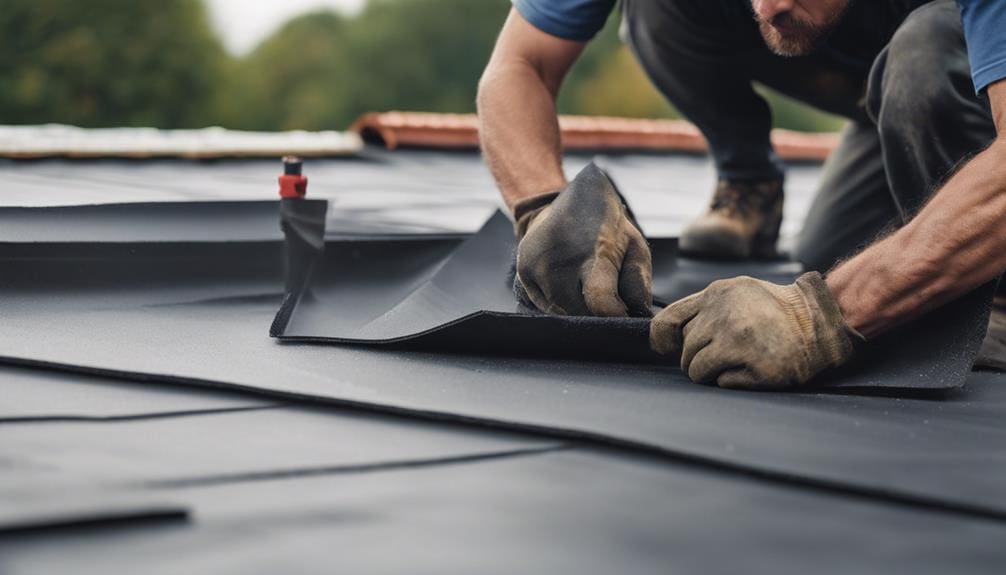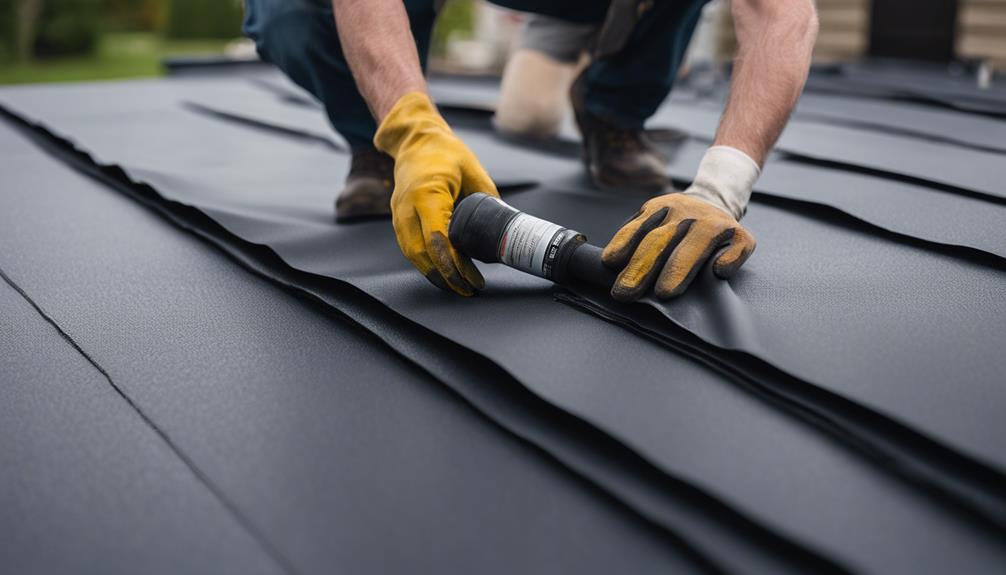When considering EPDM roof installation, understanding the meticulous process involved can make all the difference in the long-term performance of your roofing system.
From the initial assessment of tools and materials required to the final steps of installation, each stage plays an essential role in ensuring a seamless and durable finish.
The significance of professional expertise cannot be understated, but what about the lesser-known tips that homeowners should be aware of before the installation begins?
Stay tuned as we unravel the complexities and nuances of EPDM roof installation that could influence the success and longevity of your roof.
Key Takeaways
- Proper installation is essential for EPDM roof longevity and performance.
- Professional installation ensures warranty protection and minimizes leaks.
- Homeowners should prepare by inspecting roofs and clearing work areas.
- Regular inspections and maintenance are crucial for extending EPDM roof lifespan.
Tools and Materials for EPDM Installation

When initiating an EPDM roof installation project, selecting the appropriate tools and materials is essential for ensuring a successful and durable outcome. EPDM, or Ethylene Propylene Diene Terpolymer, is a popular choice for flat roofs due to its durability and weather resistance.
To begin the installation process, essential tools include a utility knife for cutting the membrane, a hand roller for ensuring proper adhesion, and a scrub pad for cleaning the substrate surface.
The materials required for EPDM roof installation include the EPDM membrane itself, adhesive or tape for sealing seams, and a primer for enhancing adhesion. Additionally, it is important to have seam tape, termination bars, and flashing materials to secure edges and penetrations effectively. Proper insulation boards and fasteners are also necessary for providing thermal resistance and structural support.
Choosing high-quality tools and materials is paramount in guaranteeing the longevity and performance of the EPDM roof. By investing in the right resources upfront, you can achieve a professional installation that will protect your building for years to come.
Steps in EPDM Roof Installation
To commence the EPDM roof installation process, the initial step involves thorough surface preparation to guarantee maximum adhesion and longevity of the roofing system. The surface must be clean, dry, and free of any debris or contaminants that could hinder the adhesion of the EPDM membrane.
After preparing the surface, the next step is to measure and cut the EPDM membrane to fit the dimensions of the roof accurately. Care must be taken during this step to ensure precise cutting and proper fitting of the membrane.
Once the EPDM membrane is cut to size, it is then laid out on the roof and positioned carefully. Adhesives or fasteners are used to secure the membrane in place, ensuring that it is wrinkle-free and properly aligned. Seams and edges are then sealed with specially formulated EPDM seam tape or liquid adhesives to create a watertight seal.
Importance of Professional Installation

Skillful execution of EPDM roof installation by trained professionals is pivotal to guaranteeing the durability and effectiveness of the roofing system. Professional installation offers a range of benefits that contribute to the long-term performance of the EPDM roof.
To start with, professionals have the expertise to accurately assess the roof’s condition and recommend the most suitable materials and installation techniques. This guarantees that the EPDM membrane is installed correctly, minimizing the risk of leaks and other issues that can arise from improper installation.
Additionally, professional installers are equipped with the necessary tools and skills to handle the installation process efficiently and safely. They understand the nuances of EPDM roofing systems and can navigate challenges that may arise during the installation process.
In addition, hiring professionals for EPDM roof installation typically comes with warranties that provide added protection and peace of mind for homeowners. Overall, investing in professional installation ensures that the EPDM roof is installed to the highest standards, maximizing its lifespan and performance.
Tips for Homeowners Preparing for Installation
For homeowners preparing for EPDM roof installation, proper readiness and organization are key elements to guarantee a smooth and successful process. Here are some essential tips to help you prepare effectively:
| Tip | Description | Benefits |
|---|---|---|
| Conduct a roof inspection | Check for any existing damage or issues that need to be addressed before installation. | Ensures a solid foundation for the new EPDM roof. |
| Clear the work area | Remove any obstacles or debris near the installation site to provide easy access for the crew. | Enhances safety and efficiency during installation. |
| Communicate with the roofing company | Discuss any specific requirements or concerns with the roofing company before the installation. | Promotes a clear understanding of expectations. |
| Protect surrounding landscaping | Trim overhanging branches and cover delicate plants to prevent damage during the installation. | Preserves the aesthetics of your property. |
| Make arrangements for pets | Keep pets away from the work area during the installation to ensure their safety and reduce stress. | Prevents accidents and distractions during the process. |
Longevity and Performance of EPDM Roof

Ensuring the longevity and best performance of an EPDM roof requires meticulous installation, regular maintenance, and adherence to manufacturer guidelines. EPDM roofs are known for their durability and longevity when properly cared for.
Here are key factors that influence the longevity and performance of an EPDM roof:
- Proper Installation: The initial installation must be done correctly to assure the roof’s effectiveness over time.
- Regular Inspections: Scheduled inspections help identify and address any issues promptly, preventing them from escalating.
- Timely Repairs: Any damage or leaks should be repaired promptly to prevent water infiltration and further damage.
- Cleaning and Maintenance: Keeping the roof clean and free of debris, as well as following maintenance schedules, can significantly extend its lifespan.
Frequently Asked Questions
Can EPDM Roofing Be Installed Over Existing Shingles or Other Types of Roofing Materials?
Yes, EPDM roofing can be installed over existing shingles or other types of roofing materials in certain situations. It is important to consult with a professional roofer to assess the condition and suitability of the current roofing before proceeding.
How Long Does It Typically Take to Install an EPDM Roof on a Residential Property?
The typical duration for EPDM roof installation on a residential property ranges from 1 to 3 days, depending on the size of the roof, weather conditions, and complexity of the project. Experienced professionals guarantee efficient and timely completion.
Are There Any Specific Maintenance Requirements or Considerations for EPDM Roofs After Installation?
After installing an EPDM roof, specific maintenance requirements are essential for longevity. Regular inspections, prompt repairs of any damage, keeping the roof clean, and ensuring proper drainage are vital considerations to maintain the integrity of EPDM roofs.
Can EPDM Roofing Be Easily Repaired if There Are Leaks or Damage in the Future?
EPDM roofing can be easily repaired if leaks or damage occur in the future. Professional roofers can patch or replace damaged sections, ensuring the integrity of the roof. Regular inspections and timely repairs are essential for maintaining the longevity of an EPDM roof.
Are There Any Environmental Benefits or Considerations Associated With Choosing EPDM Roofing for a Home?
When considering EPDM roofing for a home, important environmental benefits include its durability and energy efficiency. EPDM roofs can last 40-50 years, reducing waste from frequent replacements, and their reflective properties can lower cooling costs.